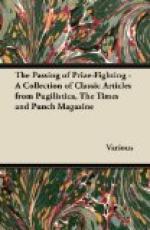But this is more than a Paradise. It is a Pandemonium, a Pantosocratic Pantechnicon and a Pantheon as well. For here, within the narrow compass of 750 pages (price 7s. 113/4d.), we find all the glory that was Greece and the grandeur that was Rome; the Olympian serenity of HOMER, the pity and terror of AESCHYLUS, the poignancy of CATULLUS, the saucy mirth of ARISTOPHANES, the sanity of SHAKSPEARE, the macabre gruesomeness of BAUDELAIRE, the sardonic rictus of HEINE and the geniality of TROLLOPE. All this and much more.
Here, as we turn every page, we expect to meet Rosalind and Jeanie Deans, Tom Jones and Aramis, Mr. Micawber and Madame Bovary, Eugenie Grandet and Colonel Newcome, Casanova and Casablanca, Consuelo and “CAGLIOSTRO,” and, if we do not meet them, we encounter new and more radiant figures, compared with whom the others are as water to wine.
Here, with its bliss and agony, its cacophony and cachinnation, is Life, such as you and I know it, not life in absolute deshabille, but enveloped in the iridescent upholstery of genius, sublimated by the wizardry of a transcendental polyphony.
Here, soaring high above the cenotaph in which the roses and rapture of our youth lie entombed in one red burial blent, we see the shimmering strands of St. Martin’s Summer drawn athwart the happenless days of Autumn, with the dewdrops of cosmic unction sparkling in the rays of a sunshine never yet seen on land or sea, but reflecting as in a magic mirror that far off El Dorado, that land where Summer always is “i-cumen in,” for which each and all of us feel a perpetual nostalgia.
Here, in fine, gentle reader, is a work of such colossal force that to render justice to its abysmal greatness we have ransacked the vocabulary of superlative laudation in vain. SWINBURNE, compared to the needs of the situation, is as a shape of quivering jelly alongside of the Rock of Gibraltar. And here, O captious critic, is a Wonderwork which not only disarms but staggers, paralyses and annihilates all possibilities of animadversion, unless you wish to share the fate of Marsyas, by pitting your puny strength against the overwhelming panoply of divine and immortal genius.
* * * * *
“A bricklayer’s
labourer was remanded yesterday on a charge of
stealing, as bailee, two matches,
value L3, the property of the
Vicar of ——.”—Provincial
Paper.
We fear there has been bad profiteering somewhere; even in London they have not touched that price.
* * * * *
“Howells’ new
violin conato (E flat), which followed, is sincere
music ... whatever there is
it is possible to bear.”—Times.
The fololwing of a conata, like the bombination of a chimaera, apparently puts some strain upon the attention of an audience.




